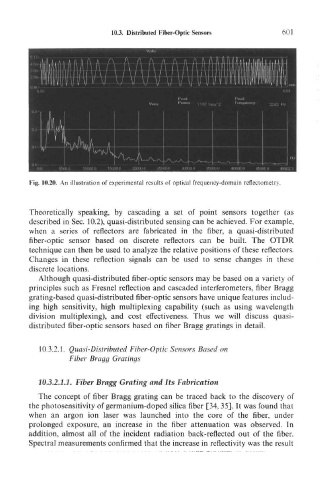Page 617 - Introduction to Information Optics
P. 617
10.3. Distributed Fiber-Optic Sensors
Fig. 1W.20. An illustration of experimental results of optical frequency-domain reflectometry.
Theoretically speaking, by cascading a set of point sensors together (as
described in Sec. 10.2), quasi-distributed sensing can be achieved. For example,
when a series of reflectors are fabricated in the fiber, a quasi-distributed
fiber-optic sensor based on discrete reflectors can be built. The OTDR
technique can then be used to analyze the relative positions of these reflectors.
Changes in these reflection signals can be used to sense changes in these
discrete locations.
Although quasi-distributed fiber-optic sensors may be based on a variety of
principles such as Fresnel reflection and cascaded interferometers, fiber Bragg
grating-based quasi-distributed fiber-optic sensors have unique features includ-
ing high sensitivity, high multiplexing capability (such as using wavelength
division multiplexing), and cost effectiveness. Thus we will discuss quasi-
distributed fiber-optic sensors based on fiber Bragg gratings in detail.
10.3.2.1. Quasi-Distributed Fiber-Optic Sensors Based on
Fiber Bragg Gratings
10.3.2.1.2. Fiber Bragg Grating and Its Fabrication
The concept of fiber Bragg grating can be traced back to the discovery of
the photosensitivity of germanium-doped silica fiber [34,35]. It was found that
when an argon ion laser was launched into the core of the fiber, under
prolonged exposure, an increase in the fiber attenuation was observed. In
addition, almost all of the incident radiation back-reflected out of the fiber.
Spectral measurements confirmed that the increase in reflectivity was the result

